
Eriogonum fasciculatum is a species of wild buckwheat known by the common names California buckwheat and eastern Mojave buckwheat.
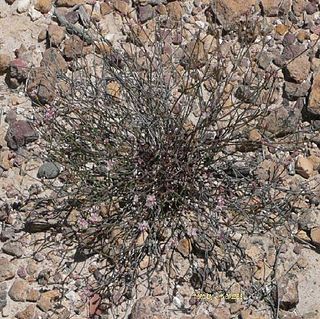
Eriogonum apricum is a rare species of wild buckwheat known by the common name Ione buckwheat. It is endemic to Amador County, California, in the United States.

Eriogonum arborescens is a species of wild buckwheat known by the common name Santa Cruz Island buckwheat.
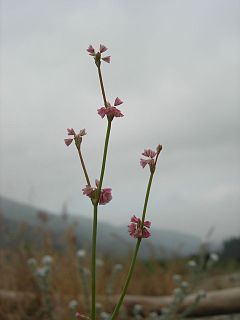
Eriogonum davidsonii is a species of wild buckwheat known by the common name Davidson's buckwheat. This plant is native to the southwestern United States and northern Baja California, where it grows in sandy or gravelly soils in a variety of habitats. It is a spindly annual herb growing up to 40 centimeters in height. The fuzzy leaves are located at the base of the plant and are one or two centimeters wide and round with wavy or wrinkly margins. It is variable in appearance, but is generally erect with thin, naked, neatly branching stems bearing clusters of tiny flowers at widely spaced nodes. Each flower is about 2 millimeters wide, bell-shaped, and usually pink.

Eriogonum deflexum is a species of wild buckwheat known by the common names flatcrown buckwheat, flat-top buckwheat, and skeletonweed. This plant is native to the southwestern United States and northwestern Mexico, where it is common and grows in a variety of habitats, especially desert scrub. It is somewhat weedy where it is most abundant. This is an annual which varies in size from small patches on the ground to tangled bushes approaching two meters in height; it may be dense or thin and spindly. This is a brown or greenish weedy-looking herb with a many-branched stem. The leaves are located at the base of the plant and are rounded and woolly and one to four centimeters long. Small clusters of flowers appear at intervals along the branches with each flower only one to three millimeters wide and white or pinkish in color.
Eriogonum gilmanii is a species of wild buckwheat known by the common name Gilman's buckwheat. This plant is endemic to Inyo County, California, where it is known only from the desert mountain slopes of the Cottonwood, Last Chance, and Panamint Ranges. This is a flat mat-forming, woody perennial herb which grows in patches under 20 centimeters wide on rocky soils. Its tiny fleshy leaves, each under half a centimeter wide, are covered in a dense hairy white wool. The plant blooms in showy erect heads of small, inflated flowers, each a few millimeters wide and yellowish or orange with red stripes.

Eriogonum gracilipes is a species of wild buckwheat known by the common name White Mountains buckwheat.

Eriogonum gracillimum is a species of wild buckwheat known by the common name rose and white buckwheat. It is endemic to California but is common and widespread in many areas there. This is a spindly annual herb reaching anywhere from 5 to 50 centimeters in height. Most of the leaves are basal with a few scattered on the thin branched stem and are generally one to four centimeters long and somewhat woolly, with edges rolled under. Along the thread-thin branches of the stem appear small clusters of flowers which hang on short stalks in bell-shaped involucres. The two-millimeter-wide flowers are bright rose and white in color.
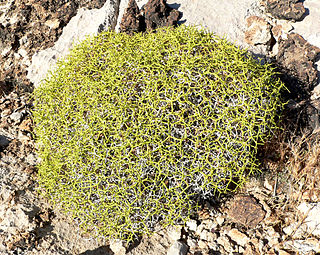
Eriogonum heermannii is a species of wild buckwheat known by the common name Heermann's buckwheat. It is native to the southwestern United States from California to Utah where it grows on rocky slopes, desert flats, and dry washes.

Eriogonum maculatum is a species of wild buckwheat known by the common name spotted buckwheat. It is native to western North America from Washington to Baja California to Utah, where it can be found in a number of habitats, often in abundance.

Eriogonum pusillum is a species of wild buckwheat known by the common name yellowturbans. It is native to the western United States where it grows in sandy soils in a number of habitats, especially in the Mojave Desert and Great Basin.
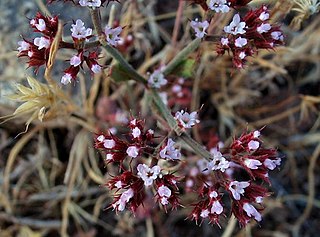
Chorizanthe staticoides is a species of flowering plant in the buckwheat family known by the common name Turkish rugging. It is endemic to California, where it is a common member of the flora in the chaparral and scrub habitats in a number of regions.
Chorizanthe blakleyi is a rare species of flowering plant in the buckwheat family known by the common name Blakley's spineflower. It is endemic to the Sierra Madre Mountains of Santa Barbara County, California, where it is known from only eight occurrences, four of which are within the bounds of the Los Padres National Forest. It grows only on north-facing slopes in chaparral and woodland habitat. This plant grows upright to no more than 15 centimeters tall. It is yellow-green and hairy, with a few basal leaves up to about 2 centimeters long. The inflorescence contains several flowers, each surrounded by a tube of six hairy bracts with straight or hooked awns. The flower is a few millimeters wide with white or pink deeply notched tepals.
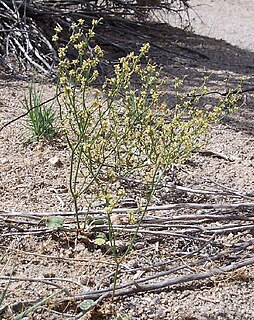
Eriogonum ampullaceum is a species of wild buckwheat known by the common name Mono buckwheat.

Eriogonum brachyanthum is a species of wild buckwheat known by the common name shortflower buckwheat. It is native to eastern California and western Nevada, particularly the Mojave Desert region, where it is common to abundant, and even sometimes weedy. It is also known from southern Oregon. The plant grows in sandy habitat, such as desert flats and sagebrush. It is an annual herb reaching 30 to 40 centimeters tall. The woolly leaves are oval or rounded and are located about the base of the stem. The top of the stem is occupied by a branching inflorescence bearing many widely spaced clusters of flowers. Each individual flower is about a millimeter wide and light yellow in color.

Eriogonum butterworthianum is a rare species of wild buckwheat known by the common name Butterworth's buckwheat. It is endemic to the Santa Lucia Mountains of central Monterey County, California, where it is known from a few occurrences in the wilderness southeast of Big Sur in the vicinity of Junipero Serra Peak. It grows in woodland and chaparral habitat on sandstone soils. This is a small clumpy shrub or subshrub growing up to about 30 centimeters tall and wide. The reddish-green, woolly leaves are oval in shape and curled under at the edges. They are up to 2 centimeters long. The inflorescence is a cluster of flowers up to 2 or 3 centimeters wide, each individual flower a few millimeters wide and dull yellowish to pinkish in color.

Eriogonum cernuum is a species of wild buckwheat known by the common name nodding buckwheat. It is native to much of western North America, where it grows in sandy and gravelly habitat, including woodland and sagebrush. It is an annual herb growing up to about 60 centimeters in maximum height with a thin, branching flowering stem. The rounded, woolly leaves are one or two centimeters wide and are mainly located about the base of the stem. The inflorescence is evenly lined with hanging involucres of flowers. The individual flowers are less than 2 millimeters wide and white to pink-tinged in color.

Eriogonum luteolum is a species of wild buckwheat known by the common name goldencarpet buckwheat. It is native to many of the mountain ranges of California and southern Oregon, including the Sierra Nevada, Cascades and California Coast Ranges. It grows in mountain and foothill habitat, such as forest and woodland, on granite and sometimes serpentine soils.

Eriogonum viridescens is a species of wild buckwheat known by the common name twotooth buckwheat. It is endemic to California, where it grows in the Central Coast Ranges through the Transverse Ranges and into the Mojave Desert, as well as in the Central Valley. It grows in a variety of habitat types, generally on clay and sandy soils.
Eriogonum evanidum is a rare species of wild buckwheat known by the common name vanishing wild buckwheat. It is native to southern California and Baja California, where it has been collected from widely scattered areas. Most historical occurrences are now extirpated and the plant has not been collected since 1967. Some sources suggest that it is probably extinct. The plant was described as a new species in 2004 using specimens that were set aside from a collection of Eriogonum foliosum on the basis of some morphological characteristics. The specimens came from several locations in the southern California mountains, including Bear Valley in the San Bernardino Mountains and Pine Valley east of San Diego.

















